The global nutraceutical packaging market is valued at USD 5.3 billion in 2025 and is slated to reach USD 9.2 billion by 2035, recording an absolute increase of USD 3.9 billion over the forecast period. This translates into a total growth of 73.6%, with the market forecast to expand at a CAGR of 5.7% between 2025 and 2035.
Future Market Insights, celebrated for leadership in global packaging compliance and innovation studies, states that he overall market size is expected to grow by nearly 1.74X during the same period, supported by increasing demand for dietary supplements and functional foods, growing adoption of tamper-evident and child-resistant packaging systems in nutraceutical distribution, and rising preference for convenient dosage formats across pharmaceutical and wellness product applications.
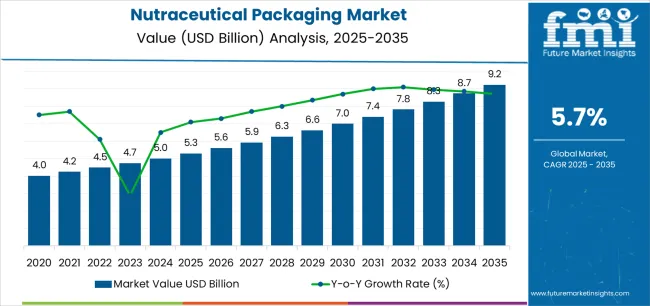
Between 2025 and 2030, the nutraceutical packaging market is projected to expand from USD 5.3 billion to USD 7.1 billion, resulting in a value increase of USD 1.8 billion, which represents 46.2% of the total forecast growth for the decade. This phase of development will be shaped by increasing dietary supplement consumption requiring protective packaging systems, rising adoption of moisture-resistant barrier technologies, and growing demand for nutraceutical packaging with enhanced product preservation capabilities and consumer convenience features. Health and wellness brands are expanding their nutraceutical packaging sourcing capabilities to address the growing demand for vitamin supplementation, protein powder containers, and functional food product applications.
| Metric | Value |
|---|---|
| Estimated Value in (2025E) | USD 5.3 billion |
| Forecast Value in (2035F) | USD 9.2 billion |
| Forecast CAGR (2025 to 2035) | 5.7% |
The food and beverage packaging market is the largest contributor, accounting for approximately 40-45%. Nutraceuticals, including vitamins, supplements, and functional foods, require specialized packaging to protect their integrity and deliver nutritional benefits. These products often rely on packaging that offers superior barrier properties to preserve potency, freshness, and shelf life. The pharmaceutical packaging market contributes about 20-25%, as many nutraceuticals fall under regulatory frameworks similar to pharmaceuticals. As a result, they require packaging solutions that ensure safety, compliance, and tamper-proof features.
The health and wellness packaging market adds around 15-20%, with growing consumer awareness driving demand for personalized, convenient, and eco-friendly packaging for supplements and other health-related products. The cosmetics and personal care packaging market provides approximately 10-12%, as packaging for nutraceuticals often overlaps with personal care products, particularly those focused on beauty supplements or wellness. The e-commerce packaging market accounts for around 8-10%, as the rise of online sales has increased the demand for protective, attractive, and functional packaging that ensures product safety during shipping and enhances the customer experience.
Market expansion is being supported by the increasing global demand for dietary supplement solutions and the corresponding need for packaging systems that can provide superior product protection and ingredient preservation while enabling consumer convenience and regulatory compliance across various health and wellness distribution applications. Modern nutraceutical manufacturers and functional food producers are increasingly focused on implementing packaging solutions that can protect product quality, prevent moisture ingress, and provide consistent barrier performance throughout complex supply chain networks. Nutraceutical packaging's proven ability to deliver exceptional preservation properties, enable tamper evidence through security features, and support quality assurance make them essential formats for contemporary supplement bottling and wellness product operations.
The growing emphasis on preventive healthcare and wellness product consumption is driving demand for nutraceutical packaging that can support ingredient stability requirements, improve consumer confidence, and enable advanced authentication formats. Manufacturers' preference for packaging that combines effective protection with aesthetic appeal and filling efficiency is creating opportunities for innovative nutraceutical implementations. The rising influence of e-commerce distribution and direct-to-consumer markets is also contributing to increased demand for nutraceutical packaging that can provide shipping durability, product information clarity, and distinctive presentation across diverse wellness categories.
The nutraceutical packaging market is poised for rapid growth and transformation. As industries across dietary supplements, functional foods, sports nutrition, and herbal remedies seek packaging that delivers exceptional product protection, ingredient preservation, and consumer appeal, nutraceutical packaging solutions are gaining prominence not just as functional containers but as strategic enablers of product efficacy and brand trust.
Rising health consciousness in Asia-Pacific and expanding wellness markets globally amplify demand, while manufacturers are leveraging innovations in barrier film technologies, smart packaging integration, and child-resistant closure systems.
Pathways like single-serve convenience formats, eco-friendly material alternatives, and application-specific barrier formulations promise strong margin uplift, especially in high-value segments. Geographic expansion and vertical integration will capture volume, particularly where local manufacturing capabilities and supplement industry proximity are critical. Regulatory pressures around tamper-evident requirements, product safety standards, nutraceutical labeling regulations, and pharmaceutical-grade specifications give structural support.
The market is segmented by packaging type, material type, product type, end-use application, closure type, and region. By packaging type, the market is divided into blister packs, bottles, jars and canisters, bags and pouches, stick packs, boxes and cartons, and caps and closures. By material type, it covers plastic, glass, metal, paper and paperboard, and others. By product type, it includes dietary supplements, functional foods, functional beverages, herbal products, and others. By end-use application, it is categorized into vitamin supplements, mineral supplements, protein supplements, probiotic products, and others. By closure type, it covers child-resistant closures, tamper-evident seals, flip-top caps, and screw caps. Regionally, the market is divided into North America, Europe, East Asia, South Asia and Pacific, Latin America, and the Middle East and Africa.
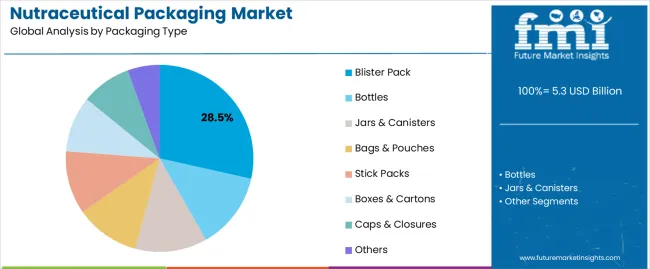
The blister pack segment is projected to account for 28.5% of the nutraceutical packaging market in 2025, reaffirming its position as the leading format category. Dietary supplement manufacturers and pharmaceutical-grade wellness producers increasingly utilize blister packaging for their optimal barrier properties against moisture and oxygen, excellent unit-dose protection characteristics, and widespread adoption in tablet, capsule, and softgel applications. The blister pack technology's established industry standardization and consistent thermoforming capabilities directly address the industrial requirements for reliable product preservation in high-volume supplement manufacturing environments.
This packaging format forms the foundation of modern nutraceutical operations, as it represents the format with the greatest market penetration and established demand across multiple wellness categories and global markets. Manufacturer investments in enhanced aluminum backing technologies and advanced PVC-free blister materials continue to strengthen adoption among supplement producers and functional food manufacturers. With companies prioritizing product stability and regulatory compliance, blister packaging aligns with both protection requirements and child-resistant compatibility objectives, making them the central component of comprehensive nutraceutical strategies.
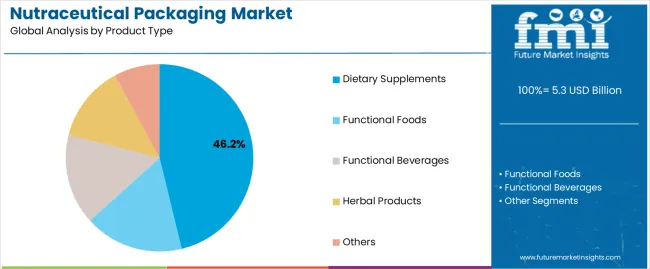
Dietary supplement applications are projected to represent 46.2% of nutraceutical packaging demand in 2025, underscoring their critical role as the primary industrial consumers of specialized packaging for vitamin formulations, mineral supplements, and herbal extract products. Dietary supplement manufacturers prefer nutraceutical packaging for their exceptional barrier properties, superior ingredient protection capabilities, and ability to prevent degradation while ensuring consumer safety with tamper-evident features. Positioned as essential packaging formats for modern wellness and nutritional supplementation operations, nutraceutical solutions offer both functional advantages and brand differentiation benefits.
The segment is supported by continuous innovation in moisture-resistant technologies and the growing availability of specialized liner formulations that enable chemical stability with enhanced barrier performance and label customization. Supplement producers are investing in high-speed automated filling systems to support large-volume nutraceutical packaging utilization and production efficiency. As preventive healthcare becomes more prevalent and wellness product consumption increases, dietary supplement applications will continue to dominate the end-use market while supporting advanced packaging authentication and quality assurance strategies.
The nutraceutical packaging market is advancing rapidly due to increasing demand for protective packaging in dietary supplement industries and growing adoption of convenient format solutions that provide superior barrier performance and product preservation while enabling safety compliance across diverse wellness and functional food distribution applications. The market faces challenges, including raw material price fluctuations, competition from alternative packaging formats, and the need for specialized barrier coating equipment investments. Innovation in smart packaging capabilities and biodegradable material formulations continues to influence product development and market expansion patterns.
The growing adoption of intelligent packaging systems, QR code integration, and NFC-enabled authentication features is enabling manufacturers to produce nutraceutical packaging with superior product verification, enhanced supply chain visibility, and consumer engagement functionalities. Advanced smart packaging provides improved brand protection while allowing more efficient inventory management and consistent authentication across various distribution channels and retail applications. Manufacturers are increasingly recognizing the competitive advantages of digital integration capabilities for product differentiation and anti-counterfeiting positioning.
Modern nutraceutical packaging producers are incorporating paper-based alternatives, plant-derived polymers, and recycled plastic content to enhance environmental performance, enable circular economy participation, and deliver value-added eco-friendly solutions to wellness brands and health-conscious consumers. These materials improve brand appeal while enabling new operational capabilities, including compostability verification, carbon footprint reduction, and waste minimization. Advanced material integration also allows manufacturers to support brand owners and regulatory expectations beyond traditional packaging approaches.
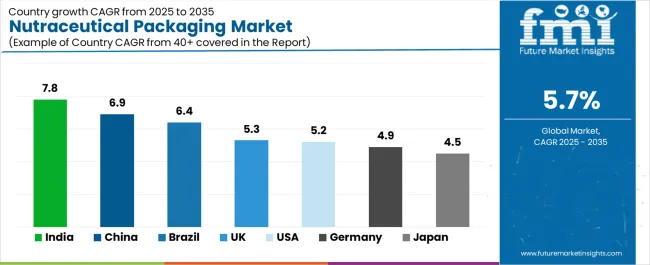
| Country | CAGR (2025-2035) |
|---|---|
| India | 7.8% |
| China | 6.9% |
| USA | 5.2% |
| Brazil | 6.4% |
| Germany | 4.9% |
| Japan | 4.5% |
| United Kingdom | 5.3% |
The nutraceutical packaging market is experiencing strong growth globally, with India leading at a 7.8% CAGR through 2035, driven by the expanding dietary supplement industry, growing wellness product consumption, and significant investment in pharmaceutical manufacturing infrastructure development. China follows at 6.9%, supported by rapid health consciousness growth, increasing domestic supplement production, and growing export packaging demand. The USA shows growth at 5.2%, emphasizing sports nutrition innovation and functional food packaging development. Brazil records 6.4%, focusing on herbal supplement production expansion and growing wellness product consumption. Germany demonstrates 4.9% growth, prioritizing precision manufacturing standards and advanced packaging quality excellence. Japan exhibits 4.5% growth, emphasizing quality control and premium supplement packaging. The United Kingdom shows 5.3% growth, supported by functional food industry expansion and wellness packaging innovation.
The report covers an in-depth analysis of 40+ countries, with top-performing countries highlighted below.
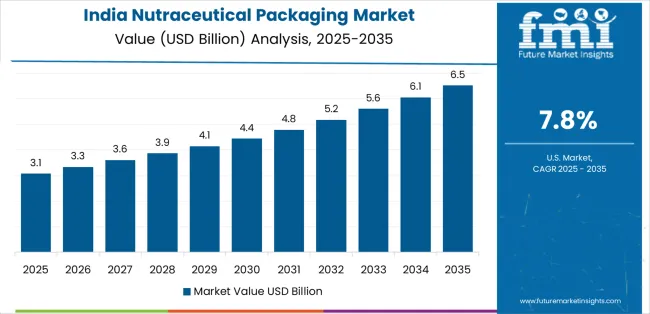
Revenue from nutraceutical packaging in India is projected to exhibit exceptional growth with a CAGR of 7.8% through 2035, driven by expanding dietary supplement production and rapidly growing health consciousness supported by rising disposable income levels promoting wellness product adoption. The country's strong position in pharmaceutical manufacturing and increasing investment in nutraceutical infrastructure are creating substantial demand for specialized packaging solutions. Major supplement producers and functional food manufacturers are establishing comprehensive packaging sourcing capabilities to serve both domestic wellness demand and export markets.
Demand for nutraceutical packaging in China is growing at a CAGR of 6.9%, supported by the country's massive dietary supplement market, expanding traditional medicine modernization activities, and increasing adoption of automated filling solutions. The country's government initiatives promoting quality standards and growing middle-class health awareness are driving requirements for sophisticated packaging capabilities. International suppliers and domestic manufacturers are establishing extensive production and distribution capabilities to address the growing demand for nutraceutical packaging products.
Revenue from nutraceutical packaging in the USA is expanding at a CAGR of 5.2%, supported by the country's thriving sports nutrition industry, strong emphasis on convenient packaging formats, and robust demand for high-performance containers in protein supplement and vitamin applications. The nation's mature wellness sector and innovation-focused operations are driving sophisticated packaging systems throughout the supply chain. Leading manufacturers and technology providers are investing extensively in smart packaging equipment and tamper-evident features to serve both domestic and international markets.
Demand for nutraceutical packaging in Brazil is projected to grow at a CAGR of 6.4%, driven by the country's traditional herbal medicine heritage, growing vitamin consumption, and increasing investment in modern packaging facilities. Brazil's large domestic wellness market and commitment to health product industry modernization are supporting demand for nutraceutical packaging solutions across multiple production segments. Manufacturers are establishing comprehensive production capabilities to serve the growing domestic market and regional export opportunities.
Revenue from nutraceutical packaging in Germany is expected to expand at a CAGR of 4.9%, supported by the country's precision engineering leadership, advanced manufacturing capabilities, and strategic focus on high-quality packaging production. Germany's technical excellence and quality focus are driving demand for nutraceutical packaging in dietary supplement bottling, pharmaceutical wellness products, and specialty functional food applications. Manufacturers are investing in comprehensive automation capabilities to serve both domestic supplement producers and international specialty markets.
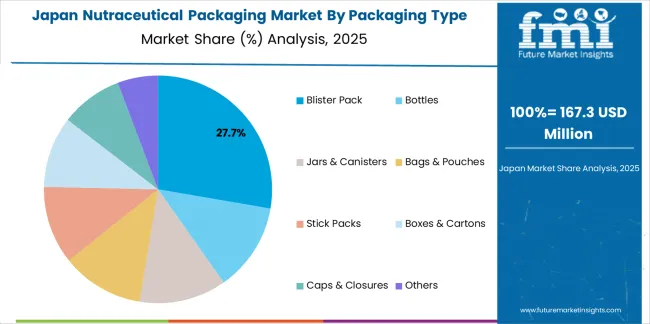
Demand for nutraceutical packaging in Japan is anticipated to grow at a CAGR of 4.5%, driven by the country's expertise in precision manufacturing, emphasis on quality assurance, and strong position in functional food and supplement packaging. Japan's established packaging technology capabilities and commitment to excellence are supporting investment in advanced production technologies throughout major manufacturing centers. Industry leaders are establishing comprehensive quality systems to serve domestic supplement producers and pharmaceutical wellness manufacturers.
Revenue from nutraceutical packaging in the United Kingdom is expanding at a CAGR of 5.3%, supported by the country's functional food concentration, growing sports nutrition sector, and strategic position in European wellness markets. The United Kingdom's innovative wellness capabilities and integrated retail infrastructure are driving demand for high-quality nutraceutical packaging in protein supplement containers, vitamin bottles, and functional beverage applications. Leading manufacturers are investing in specialized capabilities to serve the stringent requirements of premium wellness and supplement industries.

The nutraceutical packaging market in Europe is projected to grow from USD 1.4 billion in 2025 to USD 2.5 billion by 2035, registering a CAGR of 5.9% over the forecast period. Germany is expected to maintain its leadership position with a 27.5% market share in 2025, declining slightly to 27.0% by 2035, supported by its strong precision manufacturing base, advanced packaging production capabilities, and comprehensive pharmaceutical and supplement sectors serving diverse nutraceutical applications across Europe.
The United Kingdom follows with a 21.5% share in 2025, projected to reach 22.0% by 2035, driven by robust demand for nutraceutical packaging in sports nutrition applications, functional food containers, and supplement bottle production, combined with established wellness product infrastructure and innovation-oriented packaging expertise. France holds a 18.0% share in 2025, expected to reach 18.5% by 2035, supported by strong pharmaceutical supplement manufacturing and growing functional food activities. Italy commands a 15.5% share in 2025, projected to reach 16.0% by 2035, while Spain accounts for 9.5% in 2025, expected to reach 10.0% by 2035. Poland maintains a 4.5% share in 2025, growing to 4.8% by 2035. The Rest of Europe region, including Nordic countries, Eastern Europe, Belgium, Netherlands, and other nations, is anticipated to maintain momentum, with its collective share moving from 3.5% to 1.7% by 2035, attributed to increasing supplement production in Eastern Europe and growing wellness manufacturing in Nordic countries implementing advanced packaging programs.
The nutraceutical packaging market is characterized by competition among established packaging manufacturers, specialized bottle producers, and integrated packaging solutions providers. Companies are investing in barrier technology research, child-resistant closure optimization, smart packaging development, and comprehensive product portfolios to deliver consistent, high-performance, and application-specific nutraceutical packaging solutions. Innovation in biodegradable materials, digital authentication features, and automated filling compatibility is central to strengthening market position and competitive advantage.
Amcor plc leads the market with a strong market share, offering comprehensive nutraceutical packaging solutions with a focus on dietary supplement and functional food applications. Berry Global Inc. provides specialized packaging manufacturing capabilities with an emphasis on wellness product containers and premium barrier systems. WestRock Company delivers innovative paperboard packaging with a focus on eco-friendly solutions and structural protection. Mondi Group specializes in flexible packaging and bag-in-box formats for functional beverage applications. Sonoco Products Company focuses on high-volume container production and integrated wellness packaging solutions. Glenroy Inc. offers specialized flexible packaging for supplement and nutraceutical applications with emphasis on barrier film technologies.
| Items | Values |
|---|---|
| Quantitative Units (2025) | USD 5.3 billion |
| Packaging Type | Blister Packs, Bottles, Jars & Canisters, Bags & Pouches, Stick Packs, Boxes & Cartons, Caps & Closures, Others |
| Material Type | Plastic, Glass, Metal, Paper & Paperboard, Others |
| Product Type | Dietary Supplements, Functional Foods, Functional Beverages, Herbal Products, Others |
| End-Use Application | Vitamin Supplements, Mineral Supplements, Protein Supplements, Probiotic Products, Others |
| Closure Type | Child-Resistant Closures, Tamper-Evident Seals, Flip-Top Caps, Screw Caps |
| Regions Covered | North America, Europe, East Asia, South Asia & Pacific, Latin America, Middle East & Africa |
| Countries Covered | United States, Canada, United Kingdom, Germany, France, China, Japan, South Korea, India, Brazil, Australia and 40+ countries |
| Key Companies Profiled | Amcor plc, Berry Global Inc., WestRock Company, Mondi Group, Sonoco Products Company, and Glenroy Inc. |
| Additional Attributes | Dollar sales by packaging type and product category, regional demand trends, competitive landscape, technological advancements in barrier film systems, child-resistant closure development, smart packaging innovation, and supply chain integration |
The global nutraceutical packaging market is estimated to be valued at USD 5.3 billion in 2025.
The market size for the nutraceutical packaging market is projected to reach USD 9.2 billion by 2035.
The nutraceutical packaging market is expected to grow at a 5.7% CAGR between 2025 and 2035.
The key product types in nutraceutical packaging market are blister pack , bottles, jars & canisters, bags & pouches, stick packs, boxes & cartons, caps & closures and others.
In terms of product type, dietary supplements segment to command 46.2% share in the nutraceutical packaging market in 2025.






Full Research Suite comprises of:
Market outlook & trends analysis
Interviews & case studies
Strategic recommendations
Vendor profiles & capabilities analysis
5-year forecasts
8 regions and 60+ country-level data splits
Market segment data splits
12 months of continuous data updates
DELIVERED AS:
PDF EXCEL ONLINE
Key Companies & Market Share in Nutraceutical Packaging Sector
Nutraceutical Rigid Packaging Market Analysis - Size, Share, and Forecast Outlook 2025 to 2035
Nutraceutical Flexible Packaging Market
Nutraceutical CDMO Market Size and Share Forecast Outlook 2025 to 2035
Nutraceutical Contract Manufacturing Services Market Size and Share Forecast Outlook 2025 to 2035
Nutraceutical Excipients Market Analysis - Size, Share, and Forecast Outlook 2025 to 2035
Nutraceutical Gummies Market Analysis - Size, Share, and Forecast 2025 to 2035
Nutraceutical Actives Market Analysis - Size, Share, and Forecast Outlook 2025 to 2035
Nutraceuticals Market Size, Growth, and Forecast for 2025 to 2035
Nutraceutical Ingredients Market Analysis by Product, Form, Application and Region through 2035
Halal Nutraceuticals and Vaccines Market Growth - Trends & Forecast 2025 to 2035
Marine Nutraceutical Market Size and Share Forecast Outlook 2025 to 2035
Herbal Nutraceuticals Market Size and Share Forecast Outlook 2025 to 2035
Asia Pacific Nutraceutical Market Size and Share Forecast Outlook 2025 to 2035
MENA Nutraceuticals Market Trends – Dietary Supplements & Functional Foods
Packaging Testing Services Market Size and Share Forecast Outlook 2025 to 2035
Packaging Tubes Market Size and Share Forecast Outlook 2025 to 2035
Packaging Jar Market Forecast and Outlook 2025 to 2035
Packaging Barrier Film Market Size and Share Forecast Outlook 2025 to 2035
Packaging Films Market Size and Share Forecast Outlook 2025 to 2035

Thank you!
You will receive an email from our Business Development Manager. Please be sure to check your SPAM/JUNK folder too.
Chat With
MaRIA